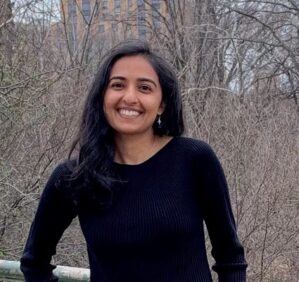
Simran Arora (M&T’19) is currently a PhD student at Stanford studying Computer Science. She visited campus this summer to meet with M&TSI students and recently sat down with us to discuss her M&T experience and why she decided to pursue her post-graduation path.
Q: You’re currently a PhD student in Computer Science at Stanford. Can you talk about your path from M&T to pursuing a PhD?
SA: M&T gave me the opportunity to consider a range of interests. Beyond the breadth of courses in the M&T curriculum, I experienced pretty different internships including software engineering, research in a few different labs, investment banking, and working at a non-profit startup. I think this was helpful to get a better sense of what motivates me at work and what I wanted to prioritize in my first few years after college. In particular, when it comes to research, I love the feeling of discovering something new. I love being able to constantly learn, form arguments using data and results, and work with amazing colleagues on questions I find super engaging.
Q: Can you talk about the research topics you are pursuing? What are your plans after graduating?
SA: In research, I’m particularly excited to develop systems that support more personalized decision making — individuals and organizations are accumulating increasing amounts of personal data from a wide variety of sources, and today’s virtual assistants incorporate very little of this.
The challenge is that there’s often a tension between personalization, privacy, and efficiency. To give a brief example, many technology organizations have tons of private code and code documentation. Software engineers at many companies cannot use tools like GitHub Copilot for privacy reasons because they would need to send their data to external model providers like OpenAI. At the same time, the open-source models still have a ways to go. The models that provide high quality tend to be quite large and are therefore difficult for many users to train and host. Finally, external tools like Copilot likely don’t train on the company’s private code, potentially limiting their ability to generate personalized content.
I’m excited to continue extending our capabilities here through my research! Post-graduation, I hope to continue conducting research in machine learning systems and teaching.
Q: How did the M&T Program prepare you for where are you today?
SA: The best way to see how different aspects of an M&T education slot in is to look at the lifecycle of a research project. Firstly, half the battle is identifying a research vision and selecting research problems. Intuitively, a strong technical foundation is helpful to solve the problem. But it’s not enough to find a solution – we need to first convince our audience that the problem we’re focused on is important and interesting, and second, convince them that our solution is the right one (i.e., we solved it with style points). Throughout this whole process, project management is important and complex. Different from jobs where several employees are assigned top-down to a project, PhD students tend to have quite a bit of flexibility when it comes to selecting and prioritizing projects. Reflecting on this process, courses on technological innovation, management, and senior design, amongst others, were helpful preparation. Also, in thinking about where the field is going and selecting projects, it’s helpful to understand the industry players and their incentives — especially in engineering where there’s a ton of industrial research output and unequal access to compute resources in industry vs. academia.
Q: What would you recommend to M&Ts as they decide what they want to pursue?
SA: Interning in investment banking is probably pretty uncommon the summer before starting computer science graduate school and the reason I changed my path was the encouragement of few of my computer science professors. My parents and close family/friends growing up were not in academia, so I really didn’t know much about it. Regardless of whether you want to do research, I would 100% recommend getting to know your professors because they’ve seen a lot of students go through the university and can help you think about what to pursue.
Q: What are a few things you’ve learned post-graduation that could be helpful advice for current M&Ts?
SA: One thing I’ve learned in my lab is that validation comes at pretty long timescales, so we shouldn’t rely on it to make decisions. In contrast, in school, we get grades/feedback right away and know how we’ll proceed through coursework semester-to-semester. There’s a lot more uncertainty if we’re developing something new – a product, company, research idea – and it’s good to get comfortable with that. On a different note, I’ve experienced working on projects where I’m lukewarm towards the idea and vision, and those where it’s all I can think about during the day. The difference is incredible and hard to communicate but stick with what you find interesting over the jobs or directions that may seem the most popular.


